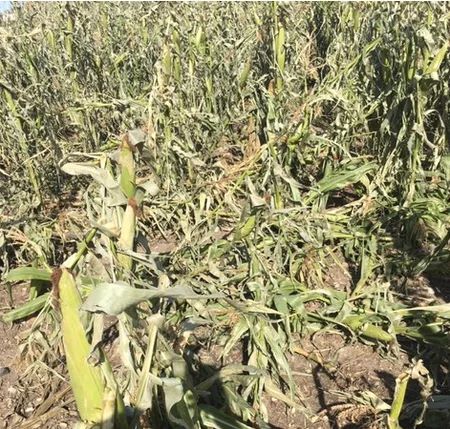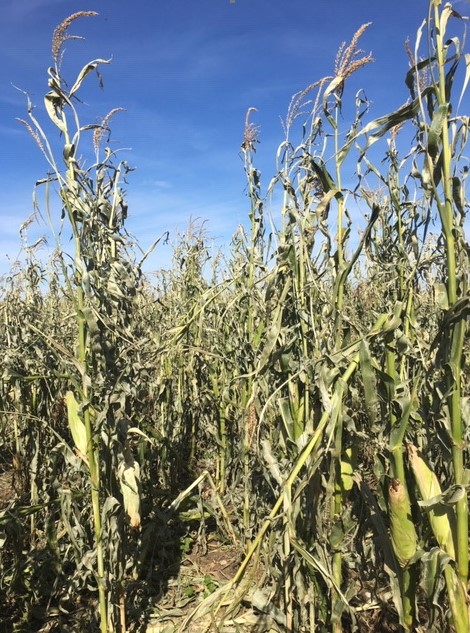
Oct 15, 2019, 1:30 PM
Corn Stalk Lodging
Stalk lodging presents itself worse in some years than others and this is one of those years. Lodging may occur near the crown, above or below the ear, and sometimes higher in the stalk. There are several factors to consider that lead to stalk lodging.
 Factors to Consider:
Factors to Consider:
When stalk lodging presents itself, consider all possible causes and recognize that a combination of factors can trigger the problem. A Purdue Agronomy Guide (AY-262*) discusses environmental conditions and management practices to reduce stalk lodging. Consider the following:
- Severe weather: Strong winds, hard driving rains and/or hail can cause major damage. Some regions had strong winds that bent stalks over. Hail and/or strong winds can also open plants up to diseases that weaken stalks.
- European corn borer: These pests can tunnel into the stalk and cause stalk breakage. Was the hybrid corn borer resistant?
- Stalk rot diseases: Stalk rot decreases the plant's ability to resist external stress by weakening the stalk tissue, making it more susceptible to stalk breakage.
- Wet soils: Saturated soils lead to poor root growth and development, which reduces the plant’s ability to access nutrients and/or fend off disease.
- Fertility: Low commodity prices lead to reducing fertility and low fertility (particularly K) may not support stalk strength. Low levels of potassium also increase the amount of premature stalk death and increase the potential for stalk rots.
- High yields: When corn maximizes yield, it needs more nutrients to support the ear and when those nutrients are unavailable, it cannibalizes the stalk.
- Crop rotation: Corn-on-corn may lead to increased insect or diseases pressure. This then can lead to an increase in overall stress which favors both stalk rot development and stalk lodging. As the insects and diseases attack the plant, they weaken stalk integrity making it lodge easier.
- Plant size: Very tall plants have more area to catch the wind, making them more susceptible to stalk lodging.
- Lignin content or linkages: Lignin varies in hybrids and may be a factor in stalk strength.
- High plant populations: Causes the plants to become tall and thin therefore they are more likely to lodge due to spindly stalks.
Action Plan
For the present year: Evaluate fields to determine stalk lodging potential. Then, plan harvest of highest risk fields first.
- Push Test: Push the plants to assess how easily they buckle and lodge. Place your hand above the ear and push the corn stalk into the next row until the top of the plant touches the neighboring corn row (about a 45-degree angle). As you release the plants, some will spring back to an upright position and others will be lodged over. If 10-15 percent or more of the plants are weak, that means the field is at risk for lodging and should be harvested early.
- Pinch Test: Pinch stalks a foot above the ground to see if they collapse. Pinch the stalk between your fingers six to twelve inches above the ground. Weak stalks will feel hollow and easily collapse. Strong stalks will be very hard to pinch. Stalks that are easily compressed are at risk of lodging and fields with 10-15 percent or more of soft stalks should be targeted for early harvest.
- Split stalks: The most accurate way to determine stalk rot issues is to cut a stalk open and look for discoloration or shredded pith in the stalk. Be sure to split stalks, especially below the soil line into the root zone to check for crown rot or discoloration.
For the next growing season: Be proactive and evaluate why certain fields or areas in a field lodge. Create a plan to minimize stalk lodging potential. Recognize that environmental factors vary and are uncontrollable. Target those factors that can be changed to avoid the problem for next year.
- Make sure to soil sample and fertilize according to test recommendations. Maintain proper fertilization, keeping a good balance of potassium to nitrogen .
- Reduce planting populations to develop a bigger, thicker stalk.
- Consider hybrids with in-plant insect protection to manage insect pests, like the European corn borer.
- Consider using fungicides to protect the stalks from diseases.
- Rotate fields to reduce the buildup of inoculums and avoid corn-on-corn situations.
- Select hybrids with good stalk strength, staygreen and lodging scores.
 Summary
Summary
Stalk lodging is a concern every year and fertility, plant population, insect and disease control, together with hybrid selection help reduce that risk. Visit with your Legend Seeds Representative for management tips in avoiding stalk lodging issues.
Resources
* Agronomy Guide AY-262. Stalk Lodging in Corn: Guidelines for Preventive Management. Bob Nielsen, Extension Agronomist, and Deb Colville, Graduate Research Assistant. Department of Agronomy, Purdue University
https://www.extension.purdue.edu/extmedia/AY/AY-262.html

